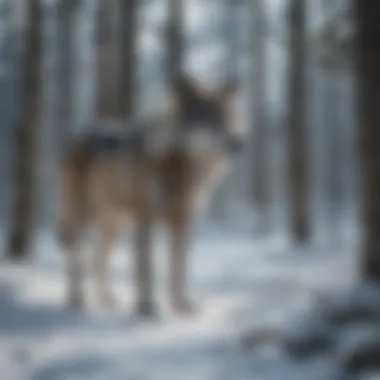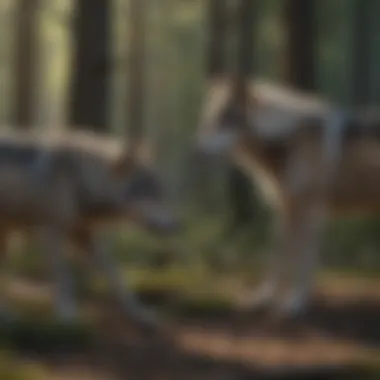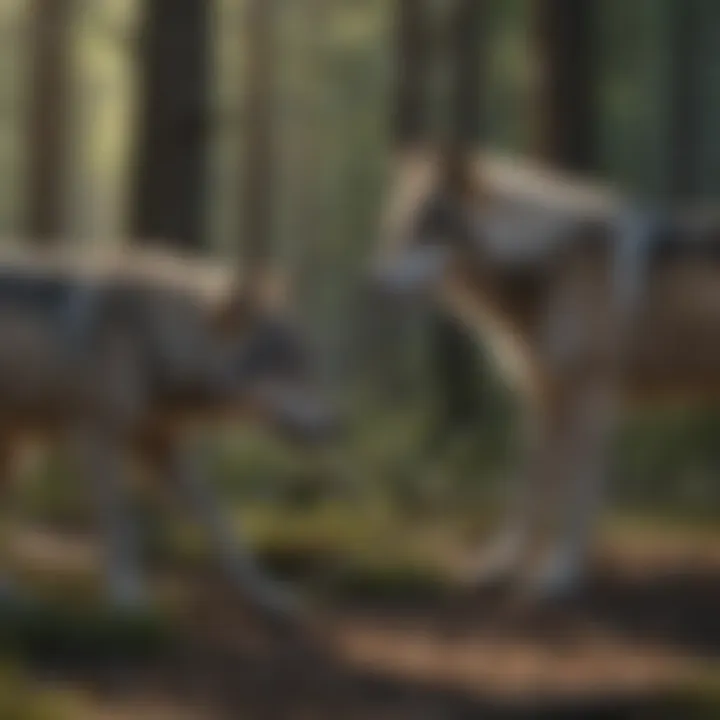Gray Wolf Adaptations: Nature's Mastery in Survival


Intro
The gray wolf, scientifically known as Canis lupus, stands as a testament to adaptability. Found across a broad spectrum of environments, from dense forests to arid deserts, this species has developed an array of adaptations that ensure its survival. Examining the ways in which the gray wolf adjusts to its surroundings provides crucial insights into its ecological roles. Such adaptations not only affect its hunting and social behaviors but also influence conservation strategies aimed at preserving the species in the wild.
Article Overview
Purpose of the Article
This article explores the diverse adaptations of the gray wolf, delving into its physical, behavioral, and ecological traits. The intent is to provide readers with an understanding of how these factors contribute to the species' success in various habitats. Key aspects discussed will include hunting strategies, social behavior, and environmental interactions.
Relevance to Multiple Disciplines
Understanding the gray wolf's adaptations holds significance for multiple fields, including ecology, animal behavior, and conservation biology. Each discipline offers a different perspective, enhancing a holistic understanding of this iconic species. This examination will appeal to students, researchers, educators, and professionals seeking to grasp the complexities of nature and the importance of preserving biodiversity.
Research Background
Historical Context
The gray wolf has a storied history, long regarded as both a revered creature and a misunderstood predator. Historically, the interactions between wolves and humans have significantly influenced their population dynamics. Understanding these historical patterns aids in grasping current conservation efforts and the challenges wolves face today.
Key Concepts and Definitions
In examining gray wolf adaptations, key terms need clarification:
- Adaptation: A change or adjustment in behavior or physiology, enhancing survival.
- Ecological Role: The position an organism occupies in its environment, including its interactions with other species.
- Conservation Biology: A field dedicated to studying and protecting biodiversity.
This foundational knowledge sets the stage for a deeper exploration into the remarkable adaptations of the gray wolf.
Prologue to Gray Wolves
The gray wolf, scientifically known as Canis lupus, occupies a prominent role in ecosystems across the Northern Hemisphere. Understanding this species is essential, as it brings to light the intricate web of interactions between them and their habitats. Gray wolves have adapted over time to a variety of environmental conditions, exhibiting remarkable traits that contribute to their survival and ecological impact. The significance of examining gray wolves extends beyond mere academic interest; it informs conservation strategies that are crucial for maintaining biodiversity.
Historical Overview
The history of gray wolves is marked by their adaptability and resilience. Once widespread across regions of North America, Europe, and Asia, human expansion has drastically reduced their range. Historical accounts indicate that gray wolves were revered and feared in ancient cultures, often symbolizing strength and cunning. The expansion of agriculture and urbanization in the 19th and 20th centuries led to the near extinction of wolves in many areas.
However, various restoration efforts have helped some populations recover. For instance, the reintroduction of gray wolves in Yellowstone National Park has had profound effects on the ecosystem. It highlights the interconnectedness of species and the importance of healthy predator populations in maintaining ecological balance. This historical context enriches the understanding of the gray wolf's current status and its ongoing role in ecosystem dynamics.
Taxonomy and Distribution
Taxonomically, gray wolves belong to the family Canidae, which includes dogs, foxes, and other similar animals. Within the species Canis lupus, there are several subspecies adapted to diverse environments. For example, the Arctic wolf (Canis lupus arctos) resides in the frigid climates of the Arctic, while the Mexican wolf (Canis lupus baileyi) is adapted to the warmer regions of the southwestern United States.
Geographically, gray wolves are primarily distributed across the tundra, forests, and deserts of North America, Europe, and parts of Asia. The population densities vary significantly based on the availability of prey and habitat suitability. Key prey species include ungulates such as deer and elk, which play a crucial role in their hunting strategies. Understanding the taxonomy and distribution of gray wolves aids in conservation efforts, as it allows for targeted strategies tailored to specific populations and their unique ecological contexts.
"The gray wolf's adaptability across various geographic regions showcases its evolutionary success in the face of changing environmental and human-induced pressures."
"The gray wolf's adaptability across various geographic regions showcases its evolutionary success in the face of changing environmental and human-induced pressures."
In summary, the introduction of gray wolves sets the stage for a deeper exploration of their adaptations. It is essential to grasp their historical significance and taxonomic diversity, as these factors are critical in forming effective conservation strategies and understanding their ecological roles.
Physical Adaptations
The gray wolf exhibits a range of physical adaptations that play a significant role in its survival across various ecosystems. These adaptations are crucial because they enhance the wolf's ability to hunt, thrive, and reproduce in different environments. Understanding these traits is essential, as they represent the intersection of physiology and environmental challenges, allowing for insights into how species interact with their habitats.
Body Structure and Size


The body structure and size of the gray wolf are vital indicators of its adaptability. Adult wolves typically weigh between 50 to 110 pounds, depending on their subspecies and region. This size provides advantages for hunting larger prey, such as deer and elk, while enabling agility to navigate diverse terrains.
In terms of body structure, wolves possess long legs and a lean build, which enhance their endurance. This physical configuration supports their hunting strategy, involving long-distance pursuits. Their powerful muscles allow them to sprint short distances effectively, giving them an edge when chasing prey. Additionally, their keen senses, particularly sight and smell, complement their physical abilities, making them proficient hunters.
Fur and Insulation
The fur of a gray wolf serves multiple functions, essential for survival in various climates. It acts as insulation, protecting the wolf against cold temperatures and harsh weather. The double-layered fur consists of a dense undercoat and longer guard hairs, providing excellent thermal regulation. Wolves living in colder regions, such as the Arctic, tend to have thicker fur compared to those in warmer areas.
Coloration plays a pivotal role as well. Wolves can be gray, brown, black, or even white, depending on their habitat. This variation aids in camouflage, helping them blend into their surroundings while hunting or avoiding threats. The ability to adapt fur color according to the environment is a critical factor in their survival strategy.
Dentition and Feeding Mechanisms
The dentition of the gray wolf reflects its carnivorous diet and hunting lifestyle. Their teeth are robust and specialized for gripping, tearing, and processing meat. The large canines are particularly important for delivering a fatal bite to prey and for subduing animals during the hunt.
Wolves also possess sharp incisors and strong molars, which facilitate the consumption of various food sources. When hunting, a wolf's feeding mechanism is not just about catching prey, but also about efficiently consuming it. They can consume up to 20 pounds of meat in one sitting. This ability is critical for survival, especially in harsh winters when food might be scarce.
"A wolf's adaptations—ranging from its body size to its dentition—highlight the intricate connection between physical traits and survival strategies in complex ecosystems."
"A wolf's adaptations—ranging from its body size to its dentition—highlight the intricate connection between physical traits and survival strategies in complex ecosystems."
In summary, the gray wolf's physical adaptations—covering body structure, fur, and dentition—are fundamental in promoting existence within varied environments. These characteristics define the wolf's role as a top predator and underscore the species' adaptability to changing ecological conditions.
Behavioral Adaptations
Behavioral adaptations are crucial for the survival of gray wolves in their natural habitats. These adaptations are not just instinctive behaviors but also learned practices that an individual or pack develops over generations. Understanding these behaviors provides insight into how wolves effectively navigate their environment, interact with each other, and respond to external threats. The significance of behavioral adaptations lies in their capacity to enhance hunting success, optimize social structures, and improve communication within the pack.
Hunting Strategies
Hunting strategies utilized by gray wolves are sophisticated and highly coordinated. Wolves typically hunt in packs, which allows them to tackle larger prey. This strategy increases their odds of securing a meal, especially when targeting ungulates such as elk or deer. Packs work together to encircle and exhaust their prey, showcasing a blend of agility and strength.
Key aspects of their hunting strategies include:
- Coordinated efforts: Members of the pack communicate through physical cues and sounds to position themselves around prey.
- Role specialization: Different wolves may take on specific roles during a hunt. For instance, some may focus on chasing, while others may block escape routes.
- Timing and patience: Wolves often exhibit patience, stalking their prey until an optimal opportunity arises for launch a coordinated attack.
When these strategies are successfully employed, they not only provide sustenance but also strengthen the bonds within the pack. This cooperation is vital as it enhances the survival rates of group members.
Pack Dynamics and Social Structure
The social structure of gray wolves is another critical behavioral adaptation. Wolves live in packs that may contain 2 to 15 individuals, although larger packs can exist. The pack is typically composed of a dominant breeding pair usually known as the alpha male and female, along with their offspring and sometimes other non-breeding adults.
- Hierarchy: The social hierarchy is maintained through vocalizations, body language, and displays of dominance or submission. This structure minimizes conflict over resources and mating rights.
- Cooperative breeding: Other pack members often help care for the young, demonstrating a complex social behavior that ensures the success of the next generation.
- Defense: Packs defend their territory against rival packs and threats, which signifies the importance of social unity in safeguarding their resources.
These dynamics illustrate the crucial role social behavior plays in the survival and reproduction of gray wolves. The cooperative nature increases the chances of survival for individuals and enhances the success of the pack as a whole.
Communication Methods
Effective communication among pack members is essential for maintaining social bonds and coordinating activities such as hunting and territory defense. Gray wolves utilize a variety of methods to convey information to one another.
- Vocalizations: Wolves are well-known for their howling, which serves multiple purposes. Howls can convey location, signal distress, or communicate within the pack during hunts.
- Body language: Posture and movements are also critical for communication. Submissive wolves may lower their bodies, while dominant wolves may stand tall with ears erect.
- Scent marking: Scent plays a large role in territorial behaviors. Wolves mark their territory using urine and feces, informing other wolves of their presence and reducing confrontations.
These communication methods not only aid in survival but also enrich social interactions, reinforcing bonds among pack members. Understanding these intricacies provides a closer look at the behavioral adaptations that allow gray wolves to thrive in myriad environments.
Ecological Adaptations
Ecological adaptations are crucial in understanding how gray wolves survive and thrive in diverse environments. These adaptations enable them to maintain their population and fulfill their ecological roles effectively. Gray wolves are not just mere survivors; they play a significant part in the ecosystems they inhabit. Understanding these adaptations gives insight into their interaction with the environment and human activities.


Territorial Behavior
Territorial behavior is essential for gray wolves. They establish territories that ensure access to resources, mates, and safety from rival packs. A wolf pack's territory can span from 50 to 1,000 square miles, depending on the availability of prey and density of other packs.
- How do wolves mark their territory? Wolves use scent markings, vocalizations, and physical signs to communicate territorial boundaries. This behavior reduces conflicts between packs and establishes clear areas for hunting and breeding.
- Importance of territoriality: By maintaining their individual territories, wolves can control resources more effectively, thus enhancing their survival chances and reproductive success.
Habitat Utilization
Habitat utilization reflects how gray wolves adapt to varying environments. They occupy a range of habitats, including forests, tundras, and grasslands. The ability to adapt to these diverse ecosystems allows them to optimize hunting strategies and social bonding.
- Resource management: Wolves rely on prey availability in their habitats. Areas rich in deer, elk, and other ungulates provide essential food resources. Their adaptability to changing environments ensures their survival even when prey populations fluctuate.
- Seasonal migration: Wolves may adjust their habitat use based on seasonal changes, moving to different areas to follow prey migrations or avoid harsh weather conditions. This flexibility is key to their long-term survival in varying climates.
Role in Ecosystems
Gray wolves play a pivotal role in maintaining the balance of ecosystems. As apex predators, they regulate prey populations, which in turn affects vegetation and overall ecosystem health.
- Trophic cascades: The presence of wolves can lead to significant ecological outcomes. For example, with fewer elk grazing in certain areas due to predation, plant life flourishes. This change positively impacts other species that rely on these plants for shelter and food.
- Biodiversity: Wolves contribute to increased biodiversity. Their hunting activity influences prey dynamics, encouraging a more vibrant ecosystem with many species.
"The absence of wolves can lead to overgrazing, resulting in habitat degradation and loss of biodiversity."
"The absence of wolves can lead to overgrazing, resulting in habitat degradation and loss of biodiversity."
Understanding ecological adaptations helps researchers and conservationists develop strategies to protect gray wolves and their habitats. Recognizing their critical role in ecosystems can foster appreciation and support for preserving natural landscapes.
Adaptations to Human Encroachment
As human activity expands, gray wolves exhibit remarkable flexibility in response to their changing environments. Understanding these adaptations is crucial for both conservation and coexistence efforts. The need for such adaptations arises from habitat loss, fragmentation, and increased human activity that influence the wolves' natural behaviors, movement patterns, and survival strategies. By examining how gray wolves alter their behavior and adapt to urban settings, we can gain insights into their resilience.
Changes in Behavior
Gray wolves have developed various behavioral adaptations in response to human encroachment. One notable change is their increased nocturnal activity. When humans are present during the day, wolves may shift their hunting and social activities to the night. This strategy helps them minimize encounters with humans, allowing them to maintain their natural predation patterns while avoiding conflicts.
In areas where wolves coexist with livestock, they often modify their hunting strategies. Instead of targeting larger prey, wolves might focus on smaller game or scavenging. This behavioral shift reduces the risk of direct conflict with humans. Additionally, wolves have been observed to travel longer distances to find suitable habitat, demonstrating their ability to adapt their ranges in search of safety.
Other changes include alterations in pack dynamics. Some wolves may become more solitary or form smaller packs when human presence is high. This adaptation can be beneficial as it lowers the chances of detection, allowing wolves to hunt and thrive in proximity to human settlements. The ability to become less reliant on pack structure showcases the gray wolf's adaptability to varying environmental pressures.
Urban Adaptation
Wolves increasingly find themselves on the peripheries of urban environments. Urban adaptation presents unique challenges and opportunities for gray wolves. In some areas, wolves have established territories that overlap with suburbs and urban regions. These adaptations are characterized by behavioral flexibility that allows them to exploit available food sources, including small animals and even garbage.
Urban ecosystems provide a different set of prey and environments, which wolves can use to their advantage. They learn the patterns of human activity and utilize times of low human activity for hunting. For instance, after dark, when most residents are indoors, wolves may venture into parks or residential areas where food sources are more abundant.
Additionally, urban-adapted wolves may exhibit altered social behaviors. They can be more tolerant of humans, adjusting their flight response to prefer avoidance rather than fleeing. This behavior may lead to increased sightings and interactions, raising concerns for both wolves and human safety.
In summary, understanding how gray wolves adapt to human encroachment is vital for future management strategies. Their remarkable behavioral changes and capacity for urban adaptation highlight the importance of studying these strategies to enhance conservation efforts while fostering coexistence with humans.
"Adaptation is not only about survival; it is about thriving in a changing world."
"Adaptation is not only about survival; it is about thriving in a changing world."
Continued research into gray wolf adaptations will inform both conservation policies and community awareness, allowing for informed decision-making that respects both wildlife and human development.
Conservation and Management
Conservation and management of gray wolves are critical for preserving their populations and ensuring their long-term survival. As keystone species, wolves play an essential role in maintaining ecological balance in their environments. Understanding their needs and addressing the threats they face can lead to effective strategies for their conservation.


Threats to Gray Wolves
Gray wolves face a plethora of threats that complicate their survival. The primary dangers include habitat loss, which arises from human encroachment, urban development, and resource extraction. Moreover, hunting and poaching significantly contribute to declining wolf numbers.
Other factors include:
- Human-wildlife conflict: When wolves prey on livestock, tensions between farmers and conservationists emerge.
- Climate change: Fluctuating temperatures and habitat alterations can disrupt prey availability and wolf dispersal patterns.
These threats create a pressing need for adaptive management that takes into account both ecological and human interests.
Conservation Strategies
A range of conservation strategies are being implemented to protect gray wolves and promote their population recovery. Effective management plans often include the following actions:
- Protected areas: Designating national parks and reserves can create safe habitats for wolves.
- Community involvement: Engaging local communities in wolf conservation fosters coexistence and understanding. Training programs on livestock protection can mitigate conflicts.
- Legislation: Enforcing laws that protect wolves from poaching is crucial. This can involve stricter penalties and monitoring systems to deter illegal activities.
Furthermore, ongoing research is essential for tracking wolf populations and understanding their behavior in changing environments.
Success Stories in Conservation
Despite challenges, there have been successful conservation efforts that illustrate the potential of effective management strategies. For instance, in Yellowstone National Park, the reintroduction of gray wolves in 1995 led to a restoration of the park's ecological balance. The return of wolves helped control elk populations, benefitting vegetation and multiple other species.
Similarly, in Europe, successful conservation programs in countries like Germany and Sweden demonstrate how adaptive management can help wolf populations stabilize. These programs often involve a combination of public education and an effective legal framework that supports coexistence.
"Wolves symbolize wildness and the untamed world, which motivates conservation programs worldwide."
"Wolves symbolize wildness and the untamed world, which motivates conservation programs worldwide."
Future Directions in Gray Wolf Research
The ongoing study of gray wolves presents an intricate blend of challenges and opportunities. As adaptive creatures, their ability to survive and flourish in diverse ecosystems offers significant insights into the dynamics of wildlife conservation and management. Future research is essential for understanding how these animals respond to rapidly changing environmental conditions and increasing human encroachment. This has implications not only for gray wolves but also for broader biodiversity and ecosystem health.
Challenges in Understanding Adaptations
Research on gray wolf adaptations involves several key challenges. First, their wide geographic range complicates the collection of consistent data across various environments. Wolves adapt uniquely to different habitats, making a one-size-fits-all approach ineffective. Furthermore, studying their behavior in the wild can be difficult. They often exist in remote areas, and their elusive nature makes direct observation a challenge.
Another issue lies in the interdisciplinary nature of adaptation studies. Researchers from ecology, genetics, and behavioral science must collaborate, bridging gaps in knowledge and methodology. This can lead to miscommunication or a lack of shared priorities.
Lastly, keeping pace with technological advancements is critical. New tools such as genetic sequencing and GPS tracking can enhance our understanding but require skills and resources that may not be accessible to all researchers.
The Role of Genetics in Adaptation
Genetics plays a vital role in how gray wolves adapt to their environment. Understanding the genetic basis of their adaptations offers insights into evolutionary processes. Genetic diversity within populations can influence their resilience to environmental changes and diseases. A well-connected gene pool often results in stronger and more adaptable populations.
Research is focusing on how specific genetic markers correlate with certain traits, such as adaptability to various prey or resilience to human disturbances. Identifying these markers can aid conservation efforts by informing breeding programs and habitat restoration efforts.
Epilogue
In evaluating the adaptations of gray wolves, the conclusion serves as a crucial summation of the findings throughout this exploration. The importance of understanding these adaptations is multifaceted. First, it sheds light on how gray wolves have evolved to become proficient survivors in diverse environments. Their capacity to adapt physically and behaviorally is significant, especially in the face of changing climates and human encroachment.
Key elements highlighted in this article include the wolves' physical traits, such as their robust body structure and specialized dentition, which enable effective hunting and securing food sources. Understanding these aspects reveals the intricate balance between physiology and ecological roles. Moreover, the behavioral adaptations, including pack dynamics and communication methods, offer insight into their social structures which facilitate cooperative hunting and, ultimately, survival.
Additionally, the ecological implications cannot be overlooked. Gray wolves play a formidable role in maintaining the health of ecosystems. Their predation regulates herbivore populations, which in turn affects vegetation and the broader ecological community. Recognizing these relationships reinforces the importance of conservation efforts aimed at preserving gray wolf populations.
Furthermore, as humans increasingly encroach on wolf habitats, it becomes necessary to consider adaptations to urban territories and changes in their behavior. This adaptability is a testament to their resilience, but it also signifies potential challenges in cohabiting with human settlements.
In summary, the comprehensive examination of gray wolf adaptations reveals not only their remarkable survival capabilities but also underscores the necessity for continued research and advocacy in conservation. As humans strive to understand and coexist with these complex creatures, fostering a deeper appreciation for their adaptations becomes essential.
The survival of gray wolves hinges upon our understanding of their adaptations and the delicate balance within their ecosystems.
The survival of gray wolves hinges upon our understanding of their adaptations and the delicate balance within their ecosystems.



